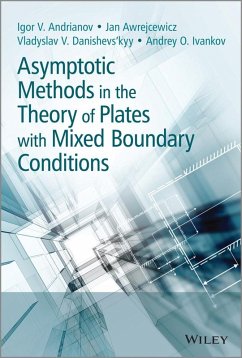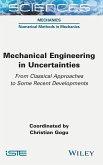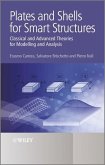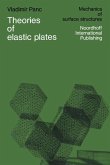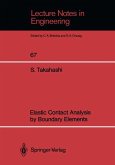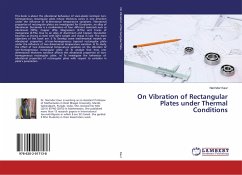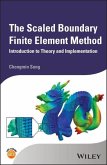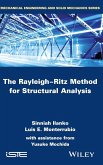Igor Andrianov, Jan Awrejcewicz, Vladyslav Danishevs'kyy, Andrey Ivankov
Asymptotic Methods in the Theory of Plates with Mixed Boundary Conditions
Igor Andrianov, Jan Awrejcewicz, Vladyslav Danishevs'kyy, Andrey Ivankov
Asymptotic Methods in the Theory of Plates with Mixed Boundary Conditions
- Gebundenes Buch
- Merkliste
- Auf die Merkliste
- Bewerten Bewerten
- Teilen
- Produkt teilen
- Produkterinnerung
- Produkterinnerung
Asymptotic Methods in the Theory of Plates with Mixed Boundary Conditions comprehensively covers the theoretical background of asymptotic approaches and their use in solving mechanical engineering-oriented problems of structural members, primarily plates (statics and dynamics) with mixed boundary conditions. The first part of this book introduces the theory and application of asymptotic methods and includes a series of approaches that have been omitted or not rigorously treated in the existing literature. These lesser known approaches include the method of summation and construction of the…mehr
Andere Kunden interessierten sich auch für
![Mechanical Engineering in Uncertainties from Classical Approaches to Some Recent Developments Mechanical Engineering in Uncertainties from Classical Approaches to Some Recent Developments]() Mechanical Engineering in Uncertainties from Classical Approaches to Some Recent Developments187,99 €
Mechanical Engineering in Uncertainties from Classical Approaches to Some Recent Developments187,99 €![Plates and Shells for Smart Structures Plates and Shells for Smart Structures]() Erasmo CarreraPlates and Shells for Smart Structures136,99 €
Erasmo CarreraPlates and Shells for Smart Structures136,99 €![Theories of elastic plates Theories of elastic plates]() V. PancTheories of elastic plates82,99 €
V. PancTheories of elastic plates82,99 €![Elastic Contact Analysis by Boundary Elements Elastic Contact Analysis by Boundary Elements]() Susumu TakahashiElastic Contact Analysis by Boundary Elements81,99 €
Susumu TakahashiElastic Contact Analysis by Boundary Elements81,99 €![On Vibration of Rectangular Plates under Thermal Conditions On Vibration of Rectangular Plates under Thermal Conditions]() Narinder KaurOn Vibration of Rectangular Plates under Thermal Conditions38,99 €
Narinder KaurOn Vibration of Rectangular Plates under Thermal Conditions38,99 €![The Scaled Boundary Finite Element Method The Scaled Boundary Finite Element Method]() Chongmin SongThe Scaled Boundary Finite Element Method153,99 €
Chongmin SongThe Scaled Boundary Finite Element Method153,99 €![The Rayleigh-Ritz Method for Structural Analysis The Rayleigh-Ritz Method for Structural Analysis]() Sinniah IlankoThe Rayleigh-Ritz Method for Structural Analysis187,99 €
Sinniah IlankoThe Rayleigh-Ritz Method for Structural Analysis187,99 €-
-
-
Asymptotic Methods in the Theory of Plates with Mixed Boundary Conditions comprehensively covers the theoretical background of asymptotic approaches and their use in solving mechanical engineering-oriented problems of structural members, primarily plates (statics and dynamics) with mixed boundary conditions. The first part of this book introduces the theory and application of asymptotic methods and includes a series of approaches that have been omitted or not rigorously treated in the existing literature. These lesser known approaches include the method of summation and construction of the asymptotically equivalent functions, methods of small and large delta, and the homotopy perturbations method. The second part of the book contains original results devoted to the solution of the mixed problems of the theory of plates, including statics, dynamics and stability of the studied objects. In addition, the applicability of the approaches presented to other related linear or nonlinear problems is addressed. Key features: - Includes analytical solving of mixed boundary value problems - Introduces modern asymptotic and summation procedures - Presents asymptotic approaches for nonlinear dynamics of rods, beams and plates - Covers statics, dynamics and stability of plates with mixed boundary conditions - Explains links between the Adomian and homotopy perturbation approaches Asymptotic Methods in the Theory of Plates with Mixed Boundary Conditions is a comprehensive reference for researchers and practitioners working in the field of Mechanics of Solids and Mechanical Engineering, and is also a valuable resource for graduate and postgraduate students from Civil and Mechanical Engineering.
Hinweis: Dieser Artikel kann nur an eine deutsche Lieferadresse ausgeliefert werden.
Hinweis: Dieser Artikel kann nur an eine deutsche Lieferadresse ausgeliefert werden.
Produktdetails
- Produktdetails
- Verlag: Wiley
- Seitenzahl: 288
- Erscheinungstermin: 7. April 2014
- Englisch
- Abmessung: 244mm x 168mm x 18mm
- Gewicht: 522g
- ISBN-13: 9781118725191
- ISBN-10: 1118725190
- Artikelnr.: 39379987
- Herstellerkennzeichnung
- Libri GmbH
- Europaallee 1
- 36244 Bad Hersfeld
- gpsr@libri.de
- Verlag: Wiley
- Seitenzahl: 288
- Erscheinungstermin: 7. April 2014
- Englisch
- Abmessung: 244mm x 168mm x 18mm
- Gewicht: 522g
- ISBN-13: 9781118725191
- ISBN-10: 1118725190
- Artikelnr.: 39379987
- Herstellerkennzeichnung
- Libri GmbH
- Europaallee 1
- 36244 Bad Hersfeld
- gpsr@libri.de
Igor V. Andrianov obtained his Master (1971) and PhD (1975) degrees from the Dnepropetrovsk State University (Ukraine). He obtained the Doctor of Sciences degree in Mechanics of Solids from the Moscow State Institute of Electronics and Mathematics (Russia) in 1990. During 1974-1977, he was a Research Scientist at the Dnipropetrovs'k State University, during 1977-1990, an Associated Professor, and during 1990-1997, a Full Professor of Mathematics in the Dnepropetrovsk Civil Engineering Institute. Currently he is a Research Scientist in the RWTH Aachen University in Germany. Prof. Andrianov is the author or co-author of 12 books and over 250 papers in refereed journals and conference proceedings. He has presented papers at numerous International Conferences, and he has supervised 25 PhD Theses. His research interests are in Mechanics of Solids, Nonlinear Dynamics, and Asymptotic Methods. Jan Awrejcewicz graduated from Lodz University of Technology in 1977 (Mechanics) and from the University of Lodz in 1978 (Philosophy). He obtained his PhD (Habilitation) in 1981 (1990), and become a Full Professor in 1997. He has authored and/or co-authored 17 monographs in English; 2 textbooks; 12 edited conference proceedings; 275 journal papers; 340 conference papers; 18 chapters in books. He has served as an editor of 9 books, and as a Guest-Editor of 15 journal special issues. His research includes Nonlinear Mechanics, Mechatronics and Control, and Biomechanics. He is a recipient of the Humboldt Research Award. Vladyslav V. Danishevs'kyy obtained his Masters (1996), Ph.D. (1999) degrees, and Doctor of Sciences degree in Structural Mechanics (2008) from the Prydniprovska State Academy of Civil Engineering and Architecture, Ukraine. He is a Professor at this State Academy. He has authored 2 monographs and over 70 refereed papers. Among his awards are the Soros Post-Graduate Student's Award (1997), Prize of the National Academy of Sciences of Ukraine for the best academic achievement among young scientists (2000), Alexander von Humboldt Foundation Research Fellowship (2001), NATO Research Fellowship (2003), NATO Reintegration Grant (2005), and institutional academic co-operation grant of the Alexander von Humboldt Foundation (2007). He conducted research at the Institute of General Mechanics in the RWTH Aachen University, Germany (2001-2002) and at the Group of Physics of Materials in the University of Rouen, France (2003-2004). His research interests are in asymptotic methods, nonlinear dynamics, and heterogeneous materials and structures. Andrey O. Ivankov, PhD is the author of more than author of more than 30 research publications. His main areas of research include ODE, PDE, Mixed BVPs and Padé approximants.
Preface ix
List of Abbreviations xiii
1 Asymptotic Approaches 1
1.1 Asymptotic Series and Approximations 1
1.1.1 Asymptotic Series 1
1.1.2 Asymptotic Symbols and Nomenclatures 5
1.2 Some Nonstandard Perturbation Procedures 8
1.2.1 Choice of Small Parameters 8
1.2.2 Homotopy Perturbation Method 10
1.2.3 Method of Small Delta 13
1.2.4 Method of Large Delta 17
1.2.5 Application of Distributions 19
1.3 Summation of Asymptotic Series 21
1.3.1 Analysis of Power Series 21
1.3.2 Padé Approximants and Continued Fractions 24
1.4 Some Applications of PA 29
1.4.1 Accelerating Convergence of Iterative Processes 29
1.4.2 Removing Singularities and Reducing the Gibbs-Wilbraham Effect 31
1.4.3 Localized Solutions 32
1.4.4 Hermite-Padé Approximations and Bifurcation Problem 34
1.4.5 Estimates of Effective Characteristics of Composite Materials 34
1.4.6 Continualization 35
1.4.7 Rational Interpolation 36
1.4.8 Some Other Applications 37
1.5 Matching of Limiting Asymptotic Expansions 38
1.5.1 Method of Asymptotically Equivalent Functions for Inversion of
Laplace Transform 38
1.5.2 Two-Point PA 41
1.5.3 Other Methods of AEFs Construction 43
1.5.4 Example: Schrödinger Equation 45
1.5.5 Example: AEFs in the Theory of Composites 46
1.6 Dynamical Edge Effect Method 49
1.6.1 Linear Vibrations of a Rod 49
1.6.2 Nonlinear Vibrations of a Rod 51
1.6.3 Nonlinear Vibrations of a Rectangular Plate 54
1.6.4 Matching of Asymptotic and Variational Approaches 58
1.6.5 On the Normal Forms of Nonlinear Vibrations of Continuous Systems 60
1.7 Continualization 61
1.7.1 Discrete and Continuum Models in Mechanics 61
1.7.2 Chain of Elastically Coupled Masses 62
1.7.3 Classical Continuum Approximation 64
1.7.4 "Splashes" 65
1.7.5 Envelope Continualization 66
1.7.6 Improvement Continuum Approximations 68
1.7.7 Forced Oscillations 69
1.8 Averaging and Homogenization 71
1.8.1 Averaging via Multiscale Method 71
1.8.2 Frozing in Viscoelastic Problems 74
1.8.3 The WKB Method 75
1.8.4 Method of Kuzmak-Whitham (Nonlinear WKB Method) 77
1.8.5 Differential Equations with Quickly Changing Coefficients 79
1.8.6 Differential Equation with Periodically Discontinuous Coefficients 84
1.8.7 Periodically Perforated Domain 88
1.8.8 Waves in Periodically Nonhomogenous Media 92
References 95
2 Computational Methods for Plates and Beams with Mixed Boundary Conditions
105
2.1 Introduction 105
2.1.1 Computational Methods of Plates with Mixed Boundary Conditions 105
2.1.2 Method of Boundary Conditions Perturbation 107
2.2 Natural Vibrations of Beams and Plates 109
2.2.1 Natural Vibrations of a Clamped Beam 109
2.2.2 Natural Vibration of a Beam with Free Ends 114
2.2.3 Natural Vibrations of a Clamped Rectangular Plate 118
2.2.4 Natural Vibrations of the Orthotropic Plate with Free Edges Lying on
an Elastic Foundation 123
2.2.5 Natural Vibrations of the Plate with Mixed Boundary Conditions
"Clamping-Simple Support" 128
2.2.6 Comparison of Theoretical and Experimental Results 133
2.2.7 Natural Vibrations of a Partially Clamped Plate 135
2.2.8 Natural Vibrations of a Plate with Mixed Boundary Conditions "Simple
Support-Moving Clamping" 140
2.3 Nonlinear Vibrations of Rods, Beams and Plates 144
2.3.1 Vibrations of the Rod Embedded in a Nonlinear Elastic Medium 144
2.3.2 Vibrations of the Beam Lying on a Nonlinear Elastic Foundation 153
2.3.3 Vibrations of the Membrane on a Nonlinear Elastic Foundation 155
2.3.4 Vibrations of the Plate on a Nonlinear Elastic Foundation 158
2.4 SSS of Beams and Plates 160
2.4.1 SSS of Beams with Clamped Ends 160
2.4.2 SSS of the Beam with Free Edges 163
2.4.3 SSS of Clamped Plate 166
2.4.4 SSS of a Plate with Free Edges 170
2.4.5 SSS of the Plate with Mixed Boundary Conditions "Clamping-Simple
Support" 172
2.4.6 SSS of a Plate with Mixed Boundary Conditions "Free Edge-Moving
Clamping" 180
2.5 Forced Vibrations of Beams and Plates 184
2.5.1 Forced Vibrations of a Clamped Beam 184
2.5.2 Forced Vibrations of Beam with Free Edges 189
2.5.3 Forced Vibrations of a Clamped Plate 190
2.5.4 Forced Vibrations of Plates with Free Edges 194
2.5.5 Forced Vibrations of Plate with Mixed Boundary Conditions
"Clamping-Simple Support" 197
2.5.6 Forced Vibrations of Plate with Mixed Boundary Conditions "Free Edge
- Moving Clamping" 202
2.6 Stability of Beams and Plates 207
2.6.1 Stability of a Clamped Beam 207
2.6.2 Stability of a Clamped Rectangular Plate 209
2.6.3 Stability of Rectangular Plate with Mixed Boundary Conditions
"Clamping-Simple Support" 211
2.6.4 Comparison of Theoretical and Experimental Results 219
2.7 Some Related Problems 221
2.7.1 Dynamics of Nonhomogeneous Structures 221
2.7.2 Method of Ishlinskii-Leibenzon 224
2.7.3 Vibrations of a String Attached to a Spring-Mass-Dashpot System 230
2.7.4 Vibrations of a String with Nonlinear BCs 233
2.7.5 Boundary Conditions and First Order Approximation Theory 238
2.8 Links between the Adomian and Homotopy Perturbation Approaches 240
2.9 Conclusions 263
References 264
Index 269
List of Abbreviations xiii
1 Asymptotic Approaches 1
1.1 Asymptotic Series and Approximations 1
1.1.1 Asymptotic Series 1
1.1.2 Asymptotic Symbols and Nomenclatures 5
1.2 Some Nonstandard Perturbation Procedures 8
1.2.1 Choice of Small Parameters 8
1.2.2 Homotopy Perturbation Method 10
1.2.3 Method of Small Delta 13
1.2.4 Method of Large Delta 17
1.2.5 Application of Distributions 19
1.3 Summation of Asymptotic Series 21
1.3.1 Analysis of Power Series 21
1.3.2 Padé Approximants and Continued Fractions 24
1.4 Some Applications of PA 29
1.4.1 Accelerating Convergence of Iterative Processes 29
1.4.2 Removing Singularities and Reducing the Gibbs-Wilbraham Effect 31
1.4.3 Localized Solutions 32
1.4.4 Hermite-Padé Approximations and Bifurcation Problem 34
1.4.5 Estimates of Effective Characteristics of Composite Materials 34
1.4.6 Continualization 35
1.4.7 Rational Interpolation 36
1.4.8 Some Other Applications 37
1.5 Matching of Limiting Asymptotic Expansions 38
1.5.1 Method of Asymptotically Equivalent Functions for Inversion of
Laplace Transform 38
1.5.2 Two-Point PA 41
1.5.3 Other Methods of AEFs Construction 43
1.5.4 Example: Schrödinger Equation 45
1.5.5 Example: AEFs in the Theory of Composites 46
1.6 Dynamical Edge Effect Method 49
1.6.1 Linear Vibrations of a Rod 49
1.6.2 Nonlinear Vibrations of a Rod 51
1.6.3 Nonlinear Vibrations of a Rectangular Plate 54
1.6.4 Matching of Asymptotic and Variational Approaches 58
1.6.5 On the Normal Forms of Nonlinear Vibrations of Continuous Systems 60
1.7 Continualization 61
1.7.1 Discrete and Continuum Models in Mechanics 61
1.7.2 Chain of Elastically Coupled Masses 62
1.7.3 Classical Continuum Approximation 64
1.7.4 "Splashes" 65
1.7.5 Envelope Continualization 66
1.7.6 Improvement Continuum Approximations 68
1.7.7 Forced Oscillations 69
1.8 Averaging and Homogenization 71
1.8.1 Averaging via Multiscale Method 71
1.8.2 Frozing in Viscoelastic Problems 74
1.8.3 The WKB Method 75
1.8.4 Method of Kuzmak-Whitham (Nonlinear WKB Method) 77
1.8.5 Differential Equations with Quickly Changing Coefficients 79
1.8.6 Differential Equation with Periodically Discontinuous Coefficients 84
1.8.7 Periodically Perforated Domain 88
1.8.8 Waves in Periodically Nonhomogenous Media 92
References 95
2 Computational Methods for Plates and Beams with Mixed Boundary Conditions
105
2.1 Introduction 105
2.1.1 Computational Methods of Plates with Mixed Boundary Conditions 105
2.1.2 Method of Boundary Conditions Perturbation 107
2.2 Natural Vibrations of Beams and Plates 109
2.2.1 Natural Vibrations of a Clamped Beam 109
2.2.2 Natural Vibration of a Beam with Free Ends 114
2.2.3 Natural Vibrations of a Clamped Rectangular Plate 118
2.2.4 Natural Vibrations of the Orthotropic Plate with Free Edges Lying on
an Elastic Foundation 123
2.2.5 Natural Vibrations of the Plate with Mixed Boundary Conditions
"Clamping-Simple Support" 128
2.2.6 Comparison of Theoretical and Experimental Results 133
2.2.7 Natural Vibrations of a Partially Clamped Plate 135
2.2.8 Natural Vibrations of a Plate with Mixed Boundary Conditions "Simple
Support-Moving Clamping" 140
2.3 Nonlinear Vibrations of Rods, Beams and Plates 144
2.3.1 Vibrations of the Rod Embedded in a Nonlinear Elastic Medium 144
2.3.2 Vibrations of the Beam Lying on a Nonlinear Elastic Foundation 153
2.3.3 Vibrations of the Membrane on a Nonlinear Elastic Foundation 155
2.3.4 Vibrations of the Plate on a Nonlinear Elastic Foundation 158
2.4 SSS of Beams and Plates 160
2.4.1 SSS of Beams with Clamped Ends 160
2.4.2 SSS of the Beam with Free Edges 163
2.4.3 SSS of Clamped Plate 166
2.4.4 SSS of a Plate with Free Edges 170
2.4.5 SSS of the Plate with Mixed Boundary Conditions "Clamping-Simple
Support" 172
2.4.6 SSS of a Plate with Mixed Boundary Conditions "Free Edge-Moving
Clamping" 180
2.5 Forced Vibrations of Beams and Plates 184
2.5.1 Forced Vibrations of a Clamped Beam 184
2.5.2 Forced Vibrations of Beam with Free Edges 189
2.5.3 Forced Vibrations of a Clamped Plate 190
2.5.4 Forced Vibrations of Plates with Free Edges 194
2.5.5 Forced Vibrations of Plate with Mixed Boundary Conditions
"Clamping-Simple Support" 197
2.5.6 Forced Vibrations of Plate with Mixed Boundary Conditions "Free Edge
- Moving Clamping" 202
2.6 Stability of Beams and Plates 207
2.6.1 Stability of a Clamped Beam 207
2.6.2 Stability of a Clamped Rectangular Plate 209
2.6.3 Stability of Rectangular Plate with Mixed Boundary Conditions
"Clamping-Simple Support" 211
2.6.4 Comparison of Theoretical and Experimental Results 219
2.7 Some Related Problems 221
2.7.1 Dynamics of Nonhomogeneous Structures 221
2.7.2 Method of Ishlinskii-Leibenzon 224
2.7.3 Vibrations of a String Attached to a Spring-Mass-Dashpot System 230
2.7.4 Vibrations of a String with Nonlinear BCs 233
2.7.5 Boundary Conditions and First Order Approximation Theory 238
2.8 Links between the Adomian and Homotopy Perturbation Approaches 240
2.9 Conclusions 263
References 264
Index 269
Preface ix
List of Abbreviations xiii
1 Asymptotic Approaches 1
1.1 Asymptotic Series and Approximations 1
1.1.1 Asymptotic Series 1
1.1.2 Asymptotic Symbols and Nomenclatures 5
1.2 Some Nonstandard Perturbation Procedures 8
1.2.1 Choice of Small Parameters 8
1.2.2 Homotopy Perturbation Method 10
1.2.3 Method of Small Delta 13
1.2.4 Method of Large Delta 17
1.2.5 Application of Distributions 19
1.3 Summation of Asymptotic Series 21
1.3.1 Analysis of Power Series 21
1.3.2 Padé Approximants and Continued Fractions 24
1.4 Some Applications of PA 29
1.4.1 Accelerating Convergence of Iterative Processes 29
1.4.2 Removing Singularities and Reducing the Gibbs-Wilbraham Effect 31
1.4.3 Localized Solutions 32
1.4.4 Hermite-Padé Approximations and Bifurcation Problem 34
1.4.5 Estimates of Effective Characteristics of Composite Materials 34
1.4.6 Continualization 35
1.4.7 Rational Interpolation 36
1.4.8 Some Other Applications 37
1.5 Matching of Limiting Asymptotic Expansions 38
1.5.1 Method of Asymptotically Equivalent Functions for Inversion of
Laplace Transform 38
1.5.2 Two-Point PA 41
1.5.3 Other Methods of AEFs Construction 43
1.5.4 Example: Schrödinger Equation 45
1.5.5 Example: AEFs in the Theory of Composites 46
1.6 Dynamical Edge Effect Method 49
1.6.1 Linear Vibrations of a Rod 49
1.6.2 Nonlinear Vibrations of a Rod 51
1.6.3 Nonlinear Vibrations of a Rectangular Plate 54
1.6.4 Matching of Asymptotic and Variational Approaches 58
1.6.5 On the Normal Forms of Nonlinear Vibrations of Continuous Systems 60
1.7 Continualization 61
1.7.1 Discrete and Continuum Models in Mechanics 61
1.7.2 Chain of Elastically Coupled Masses 62
1.7.3 Classical Continuum Approximation 64
1.7.4 "Splashes" 65
1.7.5 Envelope Continualization 66
1.7.6 Improvement Continuum Approximations 68
1.7.7 Forced Oscillations 69
1.8 Averaging and Homogenization 71
1.8.1 Averaging via Multiscale Method 71
1.8.2 Frozing in Viscoelastic Problems 74
1.8.3 The WKB Method 75
1.8.4 Method of Kuzmak-Whitham (Nonlinear WKB Method) 77
1.8.5 Differential Equations with Quickly Changing Coefficients 79
1.8.6 Differential Equation with Periodically Discontinuous Coefficients 84
1.8.7 Periodically Perforated Domain 88
1.8.8 Waves in Periodically Nonhomogenous Media 92
References 95
2 Computational Methods for Plates and Beams with Mixed Boundary Conditions
105
2.1 Introduction 105
2.1.1 Computational Methods of Plates with Mixed Boundary Conditions 105
2.1.2 Method of Boundary Conditions Perturbation 107
2.2 Natural Vibrations of Beams and Plates 109
2.2.1 Natural Vibrations of a Clamped Beam 109
2.2.2 Natural Vibration of a Beam with Free Ends 114
2.2.3 Natural Vibrations of a Clamped Rectangular Plate 118
2.2.4 Natural Vibrations of the Orthotropic Plate with Free Edges Lying on
an Elastic Foundation 123
2.2.5 Natural Vibrations of the Plate with Mixed Boundary Conditions
"Clamping-Simple Support" 128
2.2.6 Comparison of Theoretical and Experimental Results 133
2.2.7 Natural Vibrations of a Partially Clamped Plate 135
2.2.8 Natural Vibrations of a Plate with Mixed Boundary Conditions "Simple
Support-Moving Clamping" 140
2.3 Nonlinear Vibrations of Rods, Beams and Plates 144
2.3.1 Vibrations of the Rod Embedded in a Nonlinear Elastic Medium 144
2.3.2 Vibrations of the Beam Lying on a Nonlinear Elastic Foundation 153
2.3.3 Vibrations of the Membrane on a Nonlinear Elastic Foundation 155
2.3.4 Vibrations of the Plate on a Nonlinear Elastic Foundation 158
2.4 SSS of Beams and Plates 160
2.4.1 SSS of Beams with Clamped Ends 160
2.4.2 SSS of the Beam with Free Edges 163
2.4.3 SSS of Clamped Plate 166
2.4.4 SSS of a Plate with Free Edges 170
2.4.5 SSS of the Plate with Mixed Boundary Conditions "Clamping-Simple
Support" 172
2.4.6 SSS of a Plate with Mixed Boundary Conditions "Free Edge-Moving
Clamping" 180
2.5 Forced Vibrations of Beams and Plates 184
2.5.1 Forced Vibrations of a Clamped Beam 184
2.5.2 Forced Vibrations of Beam with Free Edges 189
2.5.3 Forced Vibrations of a Clamped Plate 190
2.5.4 Forced Vibrations of Plates with Free Edges 194
2.5.5 Forced Vibrations of Plate with Mixed Boundary Conditions
"Clamping-Simple Support" 197
2.5.6 Forced Vibrations of Plate with Mixed Boundary Conditions "Free Edge
- Moving Clamping" 202
2.6 Stability of Beams and Plates 207
2.6.1 Stability of a Clamped Beam 207
2.6.2 Stability of a Clamped Rectangular Plate 209
2.6.3 Stability of Rectangular Plate with Mixed Boundary Conditions
"Clamping-Simple Support" 211
2.6.4 Comparison of Theoretical and Experimental Results 219
2.7 Some Related Problems 221
2.7.1 Dynamics of Nonhomogeneous Structures 221
2.7.2 Method of Ishlinskii-Leibenzon 224
2.7.3 Vibrations of a String Attached to a Spring-Mass-Dashpot System 230
2.7.4 Vibrations of a String with Nonlinear BCs 233
2.7.5 Boundary Conditions and First Order Approximation Theory 238
2.8 Links between the Adomian and Homotopy Perturbation Approaches 240
2.9 Conclusions 263
References 264
Index 269
List of Abbreviations xiii
1 Asymptotic Approaches 1
1.1 Asymptotic Series and Approximations 1
1.1.1 Asymptotic Series 1
1.1.2 Asymptotic Symbols and Nomenclatures 5
1.2 Some Nonstandard Perturbation Procedures 8
1.2.1 Choice of Small Parameters 8
1.2.2 Homotopy Perturbation Method 10
1.2.3 Method of Small Delta 13
1.2.4 Method of Large Delta 17
1.2.5 Application of Distributions 19
1.3 Summation of Asymptotic Series 21
1.3.1 Analysis of Power Series 21
1.3.2 Padé Approximants and Continued Fractions 24
1.4 Some Applications of PA 29
1.4.1 Accelerating Convergence of Iterative Processes 29
1.4.2 Removing Singularities and Reducing the Gibbs-Wilbraham Effect 31
1.4.3 Localized Solutions 32
1.4.4 Hermite-Padé Approximations and Bifurcation Problem 34
1.4.5 Estimates of Effective Characteristics of Composite Materials 34
1.4.6 Continualization 35
1.4.7 Rational Interpolation 36
1.4.8 Some Other Applications 37
1.5 Matching of Limiting Asymptotic Expansions 38
1.5.1 Method of Asymptotically Equivalent Functions for Inversion of
Laplace Transform 38
1.5.2 Two-Point PA 41
1.5.3 Other Methods of AEFs Construction 43
1.5.4 Example: Schrödinger Equation 45
1.5.5 Example: AEFs in the Theory of Composites 46
1.6 Dynamical Edge Effect Method 49
1.6.1 Linear Vibrations of a Rod 49
1.6.2 Nonlinear Vibrations of a Rod 51
1.6.3 Nonlinear Vibrations of a Rectangular Plate 54
1.6.4 Matching of Asymptotic and Variational Approaches 58
1.6.5 On the Normal Forms of Nonlinear Vibrations of Continuous Systems 60
1.7 Continualization 61
1.7.1 Discrete and Continuum Models in Mechanics 61
1.7.2 Chain of Elastically Coupled Masses 62
1.7.3 Classical Continuum Approximation 64
1.7.4 "Splashes" 65
1.7.5 Envelope Continualization 66
1.7.6 Improvement Continuum Approximations 68
1.7.7 Forced Oscillations 69
1.8 Averaging and Homogenization 71
1.8.1 Averaging via Multiscale Method 71
1.8.2 Frozing in Viscoelastic Problems 74
1.8.3 The WKB Method 75
1.8.4 Method of Kuzmak-Whitham (Nonlinear WKB Method) 77
1.8.5 Differential Equations with Quickly Changing Coefficients 79
1.8.6 Differential Equation with Periodically Discontinuous Coefficients 84
1.8.7 Periodically Perforated Domain 88
1.8.8 Waves in Periodically Nonhomogenous Media 92
References 95
2 Computational Methods for Plates and Beams with Mixed Boundary Conditions
105
2.1 Introduction 105
2.1.1 Computational Methods of Plates with Mixed Boundary Conditions 105
2.1.2 Method of Boundary Conditions Perturbation 107
2.2 Natural Vibrations of Beams and Plates 109
2.2.1 Natural Vibrations of a Clamped Beam 109
2.2.2 Natural Vibration of a Beam with Free Ends 114
2.2.3 Natural Vibrations of a Clamped Rectangular Plate 118
2.2.4 Natural Vibrations of the Orthotropic Plate with Free Edges Lying on
an Elastic Foundation 123
2.2.5 Natural Vibrations of the Plate with Mixed Boundary Conditions
"Clamping-Simple Support" 128
2.2.6 Comparison of Theoretical and Experimental Results 133
2.2.7 Natural Vibrations of a Partially Clamped Plate 135
2.2.8 Natural Vibrations of a Plate with Mixed Boundary Conditions "Simple
Support-Moving Clamping" 140
2.3 Nonlinear Vibrations of Rods, Beams and Plates 144
2.3.1 Vibrations of the Rod Embedded in a Nonlinear Elastic Medium 144
2.3.2 Vibrations of the Beam Lying on a Nonlinear Elastic Foundation 153
2.3.3 Vibrations of the Membrane on a Nonlinear Elastic Foundation 155
2.3.4 Vibrations of the Plate on a Nonlinear Elastic Foundation 158
2.4 SSS of Beams and Plates 160
2.4.1 SSS of Beams with Clamped Ends 160
2.4.2 SSS of the Beam with Free Edges 163
2.4.3 SSS of Clamped Plate 166
2.4.4 SSS of a Plate with Free Edges 170
2.4.5 SSS of the Plate with Mixed Boundary Conditions "Clamping-Simple
Support" 172
2.4.6 SSS of a Plate with Mixed Boundary Conditions "Free Edge-Moving
Clamping" 180
2.5 Forced Vibrations of Beams and Plates 184
2.5.1 Forced Vibrations of a Clamped Beam 184
2.5.2 Forced Vibrations of Beam with Free Edges 189
2.5.3 Forced Vibrations of a Clamped Plate 190
2.5.4 Forced Vibrations of Plates with Free Edges 194
2.5.5 Forced Vibrations of Plate with Mixed Boundary Conditions
"Clamping-Simple Support" 197
2.5.6 Forced Vibrations of Plate with Mixed Boundary Conditions "Free Edge
- Moving Clamping" 202
2.6 Stability of Beams and Plates 207
2.6.1 Stability of a Clamped Beam 207
2.6.2 Stability of a Clamped Rectangular Plate 209
2.6.3 Stability of Rectangular Plate with Mixed Boundary Conditions
"Clamping-Simple Support" 211
2.6.4 Comparison of Theoretical and Experimental Results 219
2.7 Some Related Problems 221
2.7.1 Dynamics of Nonhomogeneous Structures 221
2.7.2 Method of Ishlinskii-Leibenzon 224
2.7.3 Vibrations of a String Attached to a Spring-Mass-Dashpot System 230
2.7.4 Vibrations of a String with Nonlinear BCs 233
2.7.5 Boundary Conditions and First Order Approximation Theory 238
2.8 Links between the Adomian and Homotopy Perturbation Approaches 240
2.9 Conclusions 263
References 264
Index 269

